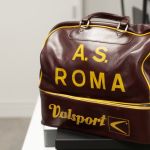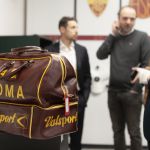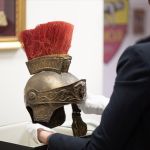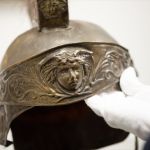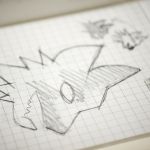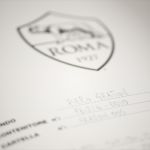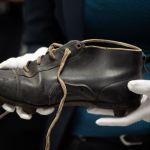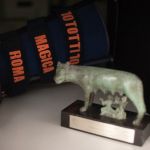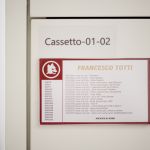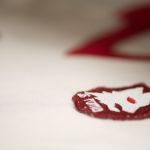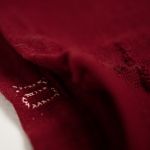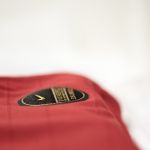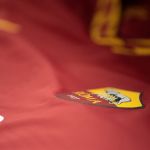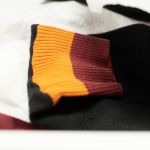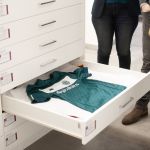
Inside AS Roma archive in Trigoria
We were guests at the launch of the Legacy Collection
March 9th, 2023
The story of a football club represents its identity, its values, its aspirations. It is a great folk tale that, like a river at high tide, carries with it, season after season, successes and defeats, tears and joys, forming downstream a collective memory made up not only of memories but also of objects, mementos and images. These are precisely what AS Roma has collected, compiled and catalogued in a decade-long project that is finally seeing the light of day. We are indeed in the archive that the Giallorossi have created in Trigoria, a unique work in the Italian world that celebrates the strong bond between the club and the eternal city. The occasion is the launch of the new Legacy Collection, a line that pays tribute to the origins of the Giallorossi with a design inspired by the iconic shirt of Società Sportiva Alba, one of the clubs whose merger in 1927 gave birth to Associazione Sportiva Roma.
Produced in collaboration with technical sponsor New Balance, the collection is the perfect example of how a modern and innovative look can be integrated based on a rigorous archiving and preservation process. The colour and design of the jersey was developed after extensive archival work that involved finding old membership cards of the team founded by Umberto Farneti to determine the right shade. The forest green was indeed a faded memory that black and white photos can not recall, while the white centre stripe is key to the jersey today as it was yesterday. "The crest was not chosen by chance, it is the first Roma wore in 1933 and is very reminiscent of that of Alba. Again, we worked in the archives,' explains Gabriele D'Urbano, who is in charge of managing the archives. "We decided not to make a copy of the past, but to transport it into the present while preserving the identity."
A work that today also faces the modern age through the use of the holographic crest, which already appears on the third jersey of this season and represents an intertwining between the sporting history and the lifestyle aspect of the team. A celebration of the club's history as it moves towards a new future, where football leaves its margins and becomes an integral part of everyday life. The relationship between the team and the city is in fact the characteristic element of the archival project of the Capitoline club, which over the years has strongly promoted a relationship with the territory, its inhabitants and also the other Roman teams. we invited representatives of the reformed Alba Roma 1907 (founded in 2020 in the midst of a pandemic, ed.) to show the jersey a few weeks ago. It was an emotional moment for everyone.
As you wander through the archive, opening drawer after drawer, you are immersed not only in the history of the club, but also in almost a century of Romanism, made up of urban transformations, cultural and technological revolutions, and traditions that overlapped until they disappeared. Like the ancient Roman helmet that the Curva Sud gave to Giancarlo De Sisti at the end of a derby won by a goal from Picchio in December 1974. At that time, there was still the custom of exchanging gifts between players and fans at important matches. In this case, a homemade helmet made from the bristles of a broom. Or the boots made for Eraldo Monzeglio, a member of the 1938 World Cup-winning national team, made of leather and with an iron sole. Or the training bag designed by Piero Gratton, which, after decades of endless shades, bore the official colours of the Giallorossi team for the first time. The archive holds the entire iconography of the Italian designer's work, including all the proofs and sketches made up to the definitive and iconic wolf-cub that AS Roma still uses on its jerseys today.
But the heart of the archive is, of course, the more than a thousand jerseys that show the history of the club like circles in a boot. Every colour, every detail, every model tells a chapter of the Giallorossi novel, whose individual pages you can flip through here. From the first jersey, made in August 1927 and entrusted to Antonio Maddaluno, a young player from the Allievi team who would later be promoted to the first team, for the entire season, to the jerseys of the 1970s with the first visible sponsor Umbro, worn during the Anglo-American tournament, to the jersey made by adidas, which has become the reference model for the next season's jersey, marking the return of the German sponsor.
Not forgetting the jerseys worn by the captains on the pitch, Di Bartolomei, De Rossi and, of course, Francesco Totti, of whom there are models for each of his seasons with the Giallorossi, from the youth team to the last one he wore when he left the Stadio Olimpico. But there are others that are in some way linked to Roma tradition, such as the jerseys of the teams the club has played against over the years - nice in this context is the 10 in mesh of the New York Cosmos that Pelé wore in a friendly match in the summer - or of the national teams represented by the Giallorossi players.
A time capsule that at the moment is still hidden in the Roman landscape, but which according to the club's plans will become the club museum in the new Roma stadium when this decade-long telenovela also comes to an end. And which, for the moment, is a great commercial asset to be used as inspiration for renewal and homage to the Giallorossi tradition.
Micol Schiona, archivist and head of the collection, explains: "It is a corporate archive created to tell the story of the brand, both as a place to go through the different parts that belong to Roma. We also collect, for example, all the logotypes, fonts and letterheads that represent the graphic history of the association, an invaluable heritage that can then be reused commercially." Like great brands, Roma's archive has commercial and historical value and will help to make the team's brand even better known around the world, linking it to that of the eternal city. To tell a great story, on the other hand, you need a deep memory, which the hundreds of objects, pictures and match jerseys collected at Trigoria help create.









































.png)


.jpg)






























